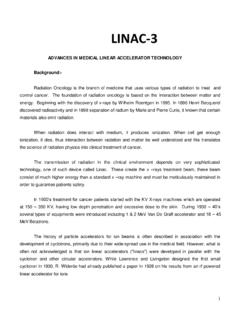Transcription of Radiation Therapy Principles - Robert B. Laughlin
1 Radiation Therapy Principles Radiation and radioactivity were discovered more than 100 years ago. Since then advances in technology and a better understanding of its effects on the body have made Radiation Therapy an important part of cancer treatment. In fact, more than half of all people with cancer will get Radiation as at least part of their cancer treatment. Here we will help you understand what Radiation Therapy is, how it is used to treat cancer, and what some of the common side effects are. For more detailed information on the possible side effects of Radiation and how to deal with them, please see our document called Understanding Radiation Therapy : A Guide for Patients and Families.
2 How does Radiation work to treat cancer? Radiation is energy that is carried by waves or a stream of particles. It damages the genes (DNA) and some of the molecules of a cell. Genes control how cells grow and divide. Radiation damages the genes of a cancer cell so that it cannot grow and divide any more. This means Radiation can be used to kill cancer cells and shrink tumors. To understand how Radiation works as a treatment, it is helpful to know about the normal life cycle of a cell. The cell cycle goes through 5 phases, one of which is the actual splitting of the cell. When a cell splits, or divides, into 2 cells, it s called mitosis.
3 The cell life cycle The cell cycle G0 = Cell is resting G1 = RNA and proteins are made S = DNA is made G2 = Apparatus for mitosis is built M = Mitosis (the cell divides into 2 cells) G0 phase (resting stage): The cell has not yet started to divide. Cells spend much of their lives in this phase. Depending on the type of cell, this step can last for a few hours or many years. When the cell gets the signal to reproduce (divide), it moves into the G1 phase. G1 phase: During this phase, the cell starts making more proteins to get ready to divide. Single strands of DNA, called RNA, are also made. This phase lasts about 18 to 30 hours. S phase: In the S phase, the chromosomes that contain the genetic code (DNA) are copied so that both of the new cells to be made will have the same DNA.
4 This phase lasts about 18 to 20 hours. G2 phase: The G2 phase is just before the cell starts splitting into 2 cells. It lasts from 2 to10 hours. M phase (mitosis): In this phase, which lasts only 30 to 60 minutes, the cell actually splits into 2 new cells that are exactly the same. The cell cycle and Radiation The cell cycle phase is important in cancer treatment because usually Radiation first kills the cells that are actively or quickly dividing. It doesn t work so fast on cells that are in the resting stage (G0) or are dividing slowly. The amount and type of Radiation that reaches the cell and the speed of cell growth affect whether and how quickly the cell will die or be damaged.
5 The term radiosensitivity describes how likely the cell is to be damaged by Radiation . Cancer cells tend to divide quickly and grow out of control. Radiation Therapy kills cancer cells that are dividing, but it also affects dividing cells of normal tissues. The damage to normal cells causes unwanted side effects. Each time Radiation Therapy is given it means balancing between destroying the cancer cells and minimizing damage to the normal cells. Radiation does not always kill cancer cells or normal cells right away. It might take days or even weeks of treatment for cells to begin dying, and they may continue to die off for months after treatment ends.
6 Tissues that grow quickly, such as skin, bone marrow, and the lining of the intestines are often affected right away. In contrast, nerve, breast, and bone tissue show later effects. For this reason, Radiation treatment can have long-term side effects that might not be seen until long after treatment is over. In the past, it was thought that once an area was treated with Radiation it could not be treated with Radiation again because of damage to the normal cells in the treatment area. But research suggests that a second course of Radiation Therapy can be given to some patients. Types of Radiation used to treat cancer Radiation used for cancer treatment is called ionizing Radiation because it forms ions (electrically charged particles) in the cells of the tissues it passes through.
7 This can kill cells or change genes so the cells cannot grow. Other forms of Radiation such as radio waves, microwaves, and light waves are called non-ionizing. They don t have as much energy and are not able to form ions. Ionizing Radiation can be sorted into 2 major types: Photons (x-rays and gamma rays), which are most widely used Particle Radiation (electrons, protons, neutrons, alpha particles, and beta particles) Some types of ionizing Radiation have more energy than others. The higher the energy, the more deeply the Radiation can penetrate (get into) the tissues. The way a certain type of Radiation behaves is important in planning Radiation treatments.
8 The Radiation oncologist (a doctor specially trained to treat cancer patients with Radiation ) selects the type and energy of Radiation that is most suitable for each patient s cancer. Sources of Radiation The more common sources of Radiation used for cancer treatment are: High-energy photons that come from radioactive sources such as cobalt, cesium, or a machine called a linear accelerator (or linac, for short). Photon beams of energy affect the cells along their path as they pass through the body to get to the cancer. This is by far the most common type of Radiation treatment in use today. Electron beams or particle beams are also produced by a linear accelerator.
9 These are used for tumors close to a body surface since they do not go deeply into tissues. Proton beams are a newer form of particle beam Radiation . Protons are charged parts of atoms that cause little damage to tissues they pass through but are very good at killing cells at the end of their path. This means that proton beams may be able to deliver more Radiation to the cancer while causing fewer side effects to normal tissues. Protons are used routinely for certain types of cancer, but still need more study in treating others. Some of the techniques used in proton treatment can also expose the patient to neutrons (see below). Proton beam Radiation Therapy requires highly specialized equipment and is currently only offered in certain medical centers.
10 See the section, What s new in Radiation Therapy ? for more about protons. Neutron beams are used for some cancers of the head, neck, and prostate and for inoperable tumors. They can sometimes be helpful when other forms of Radiation Therapy don t work. Very few facilities in the United States offer this type of treatment. Its use has declined over the years partly because of problems with getting the beams on target. Because neutrons can cause more DNA damage than photons, the effects on normal tissue may be more severe. Beams must be aimed carefully and normal tissue protected. Neutron beams are showing great promise in research with salivary gland cancers that can t be cured with surgery.










